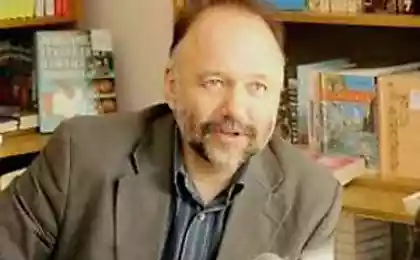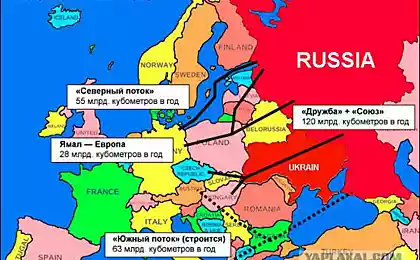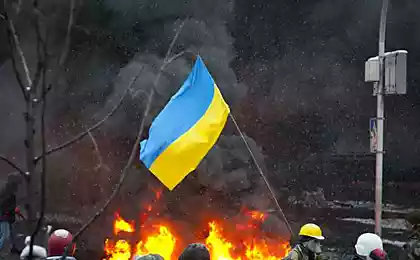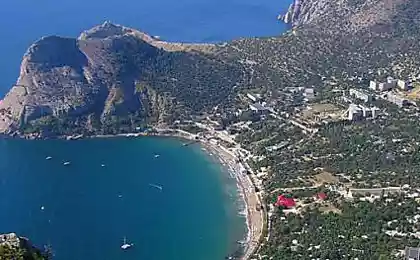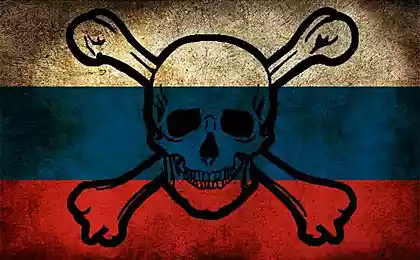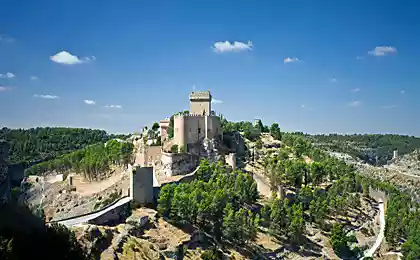1722
Ten Ukrainian castles that are worth visiting
The economic crisis is forcing Ukrainians to seek cheaper options, and returns the rest used to the fresh impressions of tourists to domestic objects. Indeed, in Ukraine a lot of wonderful natural wonders (they are not only seven), castles, fortresses and churches.
Of course, it's not all castles of Ukraine. But in this article, I selected those that in my opinion, are worth the money to buy a train ticket or burned gasoline. They are not just pretty or spectacular - they have their own special history.
Choose the most interesting for you and enjoy the beauty of the Ukrainian front.
1. Castle Khotyn Castle Kamenetz-Podolsk.
This celebrity couple did not catch up to competitors, two well-preserved fortifications, familiar from childhood on film by Sergei Tarasov about Robin Hood located at a distance of 24 km from each other. Communication between the cities of remarkable: Hawtin goes through all the buses and taxis in Chernivtsi direction.
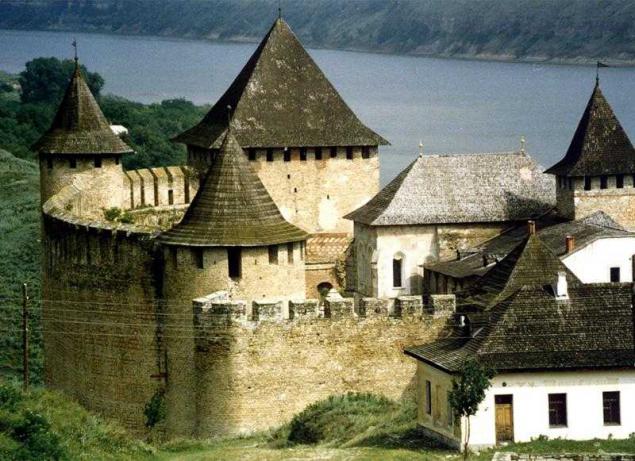
Kamenetz castle more ambitious than Khotinsk but had more roles in movies, among those that it is hard not to remember - La Rochelle in the third series of the saga of Boyarsky-Dartagnan.
Last Cinema fortresses on both the big screen took place recently, in the film "Taras Bulba" Vladimir Bortko Hawtin and Kamenetz TOGETHER somehow depict castle in Dubno. Dubno, I think, is unpleasant.
Bonus: halfway between the two castles - the former town Zhvanets. It meanders over the remains of the castle rise Zhvanchika Kalinovskys (XVII century). It seems a trifle, but it looks very picturesque, it would be a shame to miss.
Near - Soviet dot 1930s - the object for the amateur, but these fans recently not enough. Another dot, however, blown up, rises over the Dniester, in good weather with a visible Khotyn Castle.
Bonus Bonus: 6 km from Zhvanets on the way to Borschev already on the territory of Ternopil region, in the village of trenches, at the confluence of Zbruch and Dniester - another castle remains.
Trenches St. Trinity was built in the late XVII century. on the site of the ancient city with the sole purpose: not to let in a captured Turkish janissaries Kamenetz caravans with provisions and weapons. The mission was carried out in good faith, and on his return to the Polish capital skirts hands Trenches sunk into the shadows for a long time - until the moment when the local church is not entrenched, guarding against Russian soldiers, the Polish Confederates.
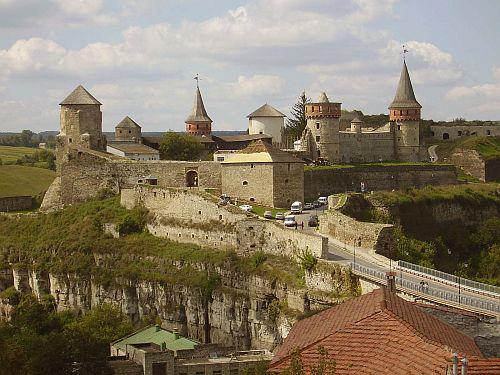
2. Castle Dubno
Podil's'ki locks, of course, are more significant, but in the Volyn strongholds have their own charm. This is especially know in the morning, when the quiet waters Ikvy displayed Castle Palace (XVIII century) and almost decorative tower Beatka.
On the tower is connected legend. In early March 1577 in the castle preparing for the wedding of a niece of the owner of the city of Prince of Ostrog, Beata. But thieves Dubna valley approached the Tatars - and guests have not been before the wedding, they fled in panic.
Surprised by the noise, the girl asked the maid what happened - and I heard about the attack of the Tatars. Beata was even and beautiful, but not too educated, the Tartars had not heard and began to inquire who they are. The maids, who were not much smarter and told that they had heard: Tatars - these are people who are born blind as sobachatami and have horns on his head. The Devils, in a word. Villains.
Resist the temptation to see people with horns Beata could not. Seeing the walls of Dubno enemy camp, the bride was so angry that came from the gun in the Khan's tent. Surprised by such events Tatars lifted the siege of Dubno.
It is this castle appears in Gogol. City residents are proud of the fact - are held annual rock festival "Taras Bulba". Other Volyn Dubna envy and create their own myths. For example, most of the residents full (here from the castle was only the shaft and deep cellars) are confident that the grave of Taras Bulba is located on the outskirts of the city.
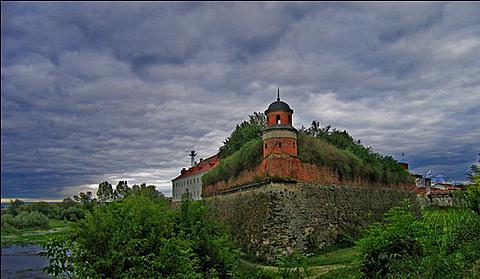
3. Castle Svirzh
Not for nothing in the Musketeers saga G.Yungvalda-Khilkevich Svirzh (Lviv) got the role Betyunskogo monastery: the image of a fortress on a hill over the smooth surface of a giant ponds, extremely soft.
From 1453 until the beginning of the XVII century the town belonged to the genus Svirzh Svirzh, which was built on the shore of the pond stronghold. On three sides of the water protects the Renaissance building, and on the fourth match of the strong defense walls and a single defense tower (chapel). Eye kinomanyaka know it: it is a bastion of Saint-Germain, where the four Musketeers had breakfast under the enemy bullets in the final scene of the movie.
Just before the First World War were completed to upgrade the lock-General Robert Lyamezan Salyans (1869-1930). September 2, 1914 mansion, set on fire by Russian troops, burned with values, family portraits and a library. Only the wall. After the war, Robert Earl persistently engaged in the restoration, involving as working three Russian prisoners of war. Able to break down - Know how and update.
Continued recovery in-law General, Count Tadeusz Komorowski (1895-1966). The restoration continued - you guessed it - until September 1939.
During the Second World War the castle was looted and partially destroyed. In Soviet times it was used as a school for tractor drivers later are scheduled to make a house of creativity of the Union of Architects. Modern facilities fate unclear: in this equation are too many unknowns.
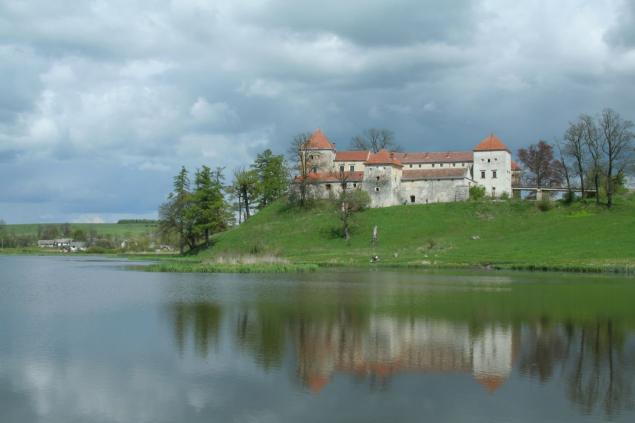
4. Castle Chervonogrud
As should puzzle the place you need to look urgently: the village with the same name is not on the map of Ukraine. It is here the maps of Ternopil will be able to find a loop of the river between the villages Dzhurin Nagiryany and Nyrkov labeled "pioneer. Camp ».
The place is - and there is no word. Some call the crater with a lock kidney - the title of one of the neighboring villages. Other styled non-existent for more than half a century Polish village for some reason on the ancient Russian style Chervonogorod.
The most appropriate Ukrainian grammar will Chervonograd name - in this case the inevitable confusion of the same miner's settlement in Lviv region. There are two options: Polish (Chervonogrud and many centuries ago - Chirvonigrod) and Ukrainian (the inhabitants of the surrounding villages have long called this place a red).
There is the Latin name of the chronicles: castrum rubrum. She, like everyone else, brightly colored red castle. Blame Brunate Podolsk sandstones providers and earth and rocks are reddish color.
At the beginning of XVII century tycoons Danilovichi instead of the old wooden fortress built here a stone castle, later corrupted by Turkish troops. In the years 1820-40 princes Poninskie dilapidated fortress walls erected neo-Gothic palace.
Above the canyon two towers. Their upper particle "crown" carried on carts all the way from the city. Inside one of the towers arranged a secret passage - it survived until now. In the chateau park can be heard the sound of a 16-meter waterfall on the creek Dzhurin.
Already in the interwar period in one of the towers of the "crown" lacked teeth: during World Russian soldiers climbed the tower and try to break off. As a result, we flew down with them.
Since 2003, the castle came hut in which lived a monk UAOC. According to his version, which replicate yellow newspaper locked the entrance to hell, who guards a headless knight. But under the ground is a hall of judgment, which will be the Last Judgment. Very surprised to cavers this name known cave "Porosyachka" that really is close to the castle ...
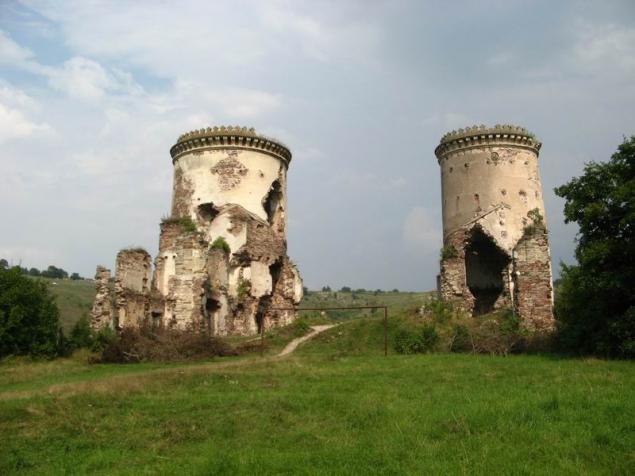
5. Castle Belgorod-Dniester
Even if you do not know what to Belgorod - one of the oldest cities in the world to marvel at in the regional center of Odessa region have a lot to: the largest of the Ukrainian fortress located here, on the high rocky bank of the Dniester estuary on the remains of the ancient city of Tira.
Two and a half kilometers of defensive walls - this is serious. Unfortunately, not all of the 34 towers have survived.
They built an outpost for two hundred years and Moldovans, and the Genoese and the Turks. The oldest part (XIII century), Citadel - a kind of fortress in the fortress.
When other parts of the fortress obey the enemy, here it was still possible to keep defenses. It is in this part of the castle lived the commandant of the fortress, housed the military headquarters.
Guides say about treasures, left here by the Turks, the amazing water system, stay here Pushkin, Lesya Ukrainka, I. Nechuy-Levitsky, K Paustovskogo, A. Mickiewicz and Kataev. And one of the towers is named after the great exile of antiquity - Ovid.
In August 1484 the 300,000th army of the Turkish Sultan Bayezid II and 50 tisyachnye troops of the Crimean Khan Giray Mengli surrounded the castle with beach and estuary. After a 16-day siege of the fortress fell. In 328 years, there is established the Turkish sovereignty.
Although the Cossacks and managed to break the peace of the Ottomans, and regularly: at the walls, and there were Ackerman Gregory Loboda, and Ivan Sirko, and Simon Paly.
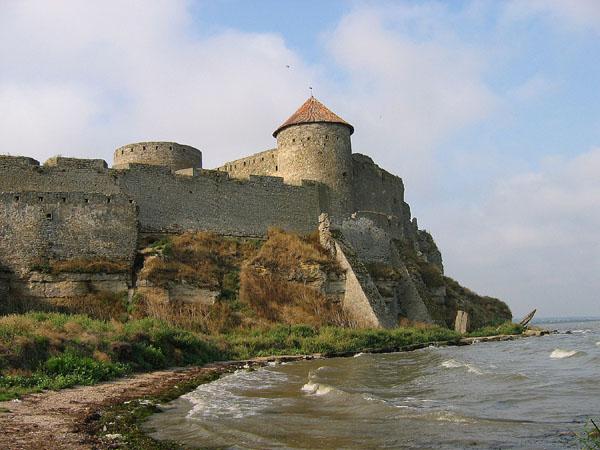
6. Castle Seredne
Premiere of the film "Angels and Demons" is devoted! The Templars in the garden! Treasures Jacques de Molay under Mukachevo! And so on.
In fact, nothing even such a mysterious and spectacular, and even less. But the influence that due to popular literature makes to the people the word "Templar" I would not underestimate become. Because just the middle of the marathon between Uzhgorod and Mukachevo - the average, and in the middle of the Middle - the remains of the Templar castle (XIII century). In the easternmost stronghold of the once powerful Order of silver stored for a mythical and banal salt and grain.
Pick up the medieval impressions on the average can be in the old wine cellars, and even tasting. And as a bonus - castles in Uzhgorod and Mukachevo. They preserved much better Templar ruins, legends about ghosts left there, so sadly will not be exact.
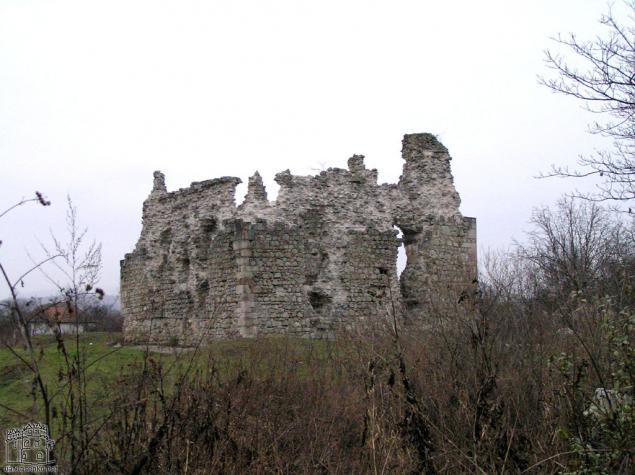
7. Castle Pike
The most famous of the Crimean fortresses built by the Genoese in the years 1371-1469 on a cone-shaped mountain Kiz-kul-breaker.
Mount millions of years ago there was a coral reef, and now dominates the spectacular sea side. Sudak fortress perfect in the spring, thousands of weary sun of summer visitors has not jostle among the many towers and cannons. Although the area of fortification is that enough for an army of holidaymakers: 30 hectares.
On a nearby hill filmed TV series "Master and Margarita", although there are soap operas, when the sight of such beauty. Even in 1365's Soldayya Sudak Genoese captured, this is where they began their expansion into the southern coast of Crimea. Hence, the non-Slavic names in the name of towers: the tower named after the Genoese consuls.
Legend has it that the Turks in 1475's were forced to resort to tricks to seize Genoese stronghold, considered impregnable: catapults throwing corpses in the courtyard of the fortress disguised as the dead bodies of plague.
Panic, which began in the fort, played into the hands of the Ottomans: the Genoese consul sailed out of the city and the townspeople surrendered unconditionally. The Turks did not spare anyone, cut out the entire population of the same day.
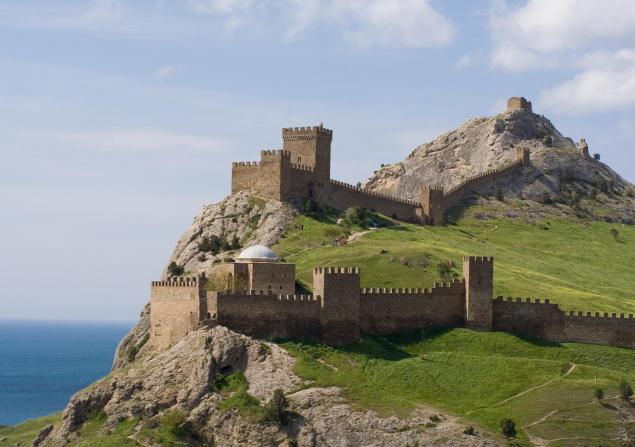
8. Castle Kremenets
So much talk about the transfer of these walls, the directors of horror movies should all be built under Mount Bona. Do not line up - and it's their fault.
We hear about the bridge of hair, built for Queen Bona, blood baths and other quirks, then remember that this artful and clever Italian had never been on the tail - and concentrate on the remains of the castle and the charming town at the foot of nearly 400 - meter mountain. Hence Kremenets all at a glance.
The legends of legends, and the castle owes much to the wife of Sigismund I, 1536 gave her Kremenets and surroundings. It has strengthened the high castle walls, three towers, barracks, farm buildings and powder flasks. Leaving for Italy after the death of her husband, she was taken from Kremenets 70 carts of different kind.
A castle continued to uphold their custody. In September 1648, Colonel Jalal Philo took the fortress under siege. Eighteen months of fierce fighting, finally, in October, the fortress was taken and destroyed. The first and last time. Since then, the castle is not restored. And Pyatnitskoe cemetery under the mountain turn white limestone crosses on the graves of Cossack.
Once the castle is the local television tower, but now only the ruins of the fortress walls rise above the chipped Kremenets.
Dreaming of treasure? In Kremenets you are not alone. In 2004, a local schoolboy fashioned device to search for hidden treasure on the mountain. The device worked, and found treasures guy, and dozens of German shells during the Second World War.
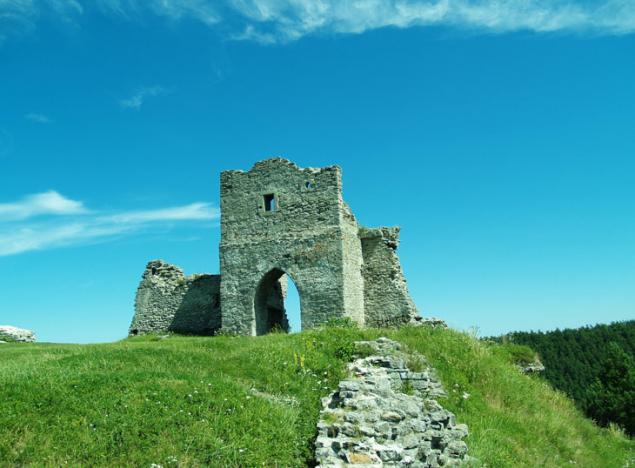
9. Castle Kudrintsy
Here's a lock for the fans and extremists. The road to this village on the border of Ternopil and Khmelnytsky region - the enemy does not want. Commuter transport is a large time intervals. Infrastructure - zero. But the beauty is such that you forgive the inconvenience, hills and broken asphalt, and the long climb up to the castle.
Gray remains of towers Zbruch trident reflected in the water, the crown crowned the high mountain shooters. The fortress was built in 1615 Gerburt tycoons, and the castle itself is not a special character has shown that the Cossacks Maxim Kryvonos with rebels villagers expel Polish garrison in the summer of 1648, the Turks captured the fortress in 1672 and 1694 respectively.
By the beginning of the XVIII century Kudrinetskaya fortress turned into a nest Gumenetsky. Eventually the residence passed to the next owner, Kozibrodskim who turned it into a kind of museum, decorated rooms of portraits and antique furniture.
To see the collection of fragments Kudrinetskogo castle can now Ternopil museum. Underpass, indispensable attribute of any romantic relic of the Middle Ages, began in the south tower, but now filled. In the south wall of the gate can be traced to a small surprise attacks on the enemy.
And as much as hunters saw this outpost - and you name it.
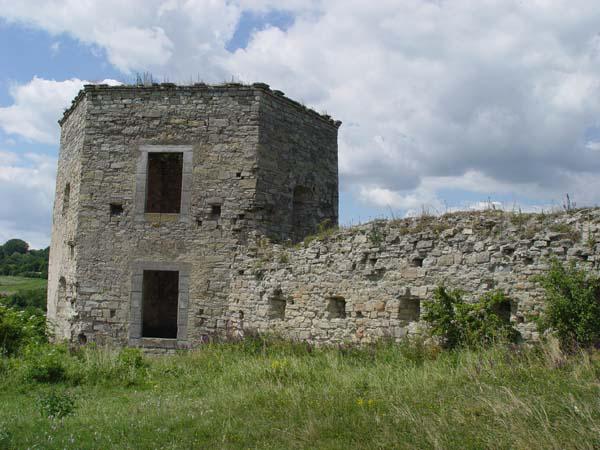
10. Castle Schönborn (Chynadiyevo)
Even the train station is like a miniature castle and the luxurious Park is hiding a real fairytale miracle. First, because of the crown appears high tower, decorated clock and family coats of arms.
Lions in the crown - in such a den could really live the king, although not crowded alleys around the monarch, and patients with cardiovascular disease, nervous system and metabolism. In these diseases, specialized resort that since 1946 is located in a luxurious hunting palace of the Counts Schonborn.
It all started in 1840 from a wooden hut where the owners graphs Schönborn frequented hunting. In 1890, for Schonborn erected a stone castle, where you can study the calendar: 365 windows, 52 rooms, 12 inputs. The contours of the pond looked like the outline of the Austro-Hungarian Empire.
Inside you can admire the stained-glass windows in the chapel, fireplace, old wooden stairs that protects the heraldic lion at their feet. The ceiling fixture: female figure made of deer antlers ...
The unusual beauty of the palace at the time interested in one of the ideologues of Nazi Hermann Goering, who in 1939 tried to buy the property from the government Augustin Voloshin. In the middle of the twentieth century, "the Carpathians" rested famous American artist Rokuel Kent, who admired the charm of the Carpathian nature and graceful architecture of the palace.
via the author Irina Pustynnikova
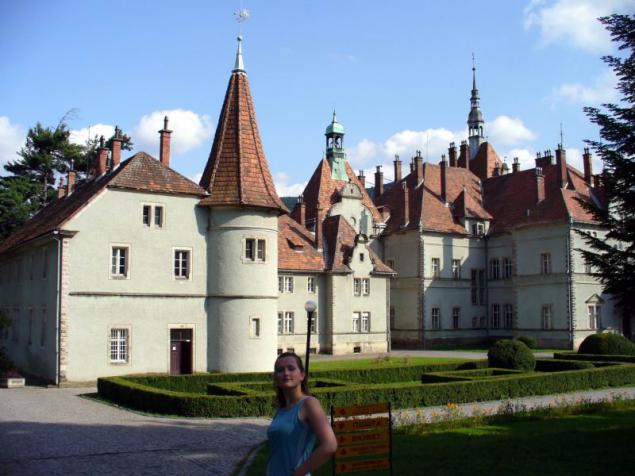
Source:
Of course, it's not all castles of Ukraine. But in this article, I selected those that in my opinion, are worth the money to buy a train ticket or burned gasoline. They are not just pretty or spectacular - they have their own special history.
Choose the most interesting for you and enjoy the beauty of the Ukrainian front.
1. Castle Khotyn Castle Kamenetz-Podolsk.
This celebrity couple did not catch up to competitors, two well-preserved fortifications, familiar from childhood on film by Sergei Tarasov about Robin Hood located at a distance of 24 km from each other. Communication between the cities of remarkable: Hawtin goes through all the buses and taxis in Chernivtsi direction.

Kamenetz castle more ambitious than Khotinsk but had more roles in movies, among those that it is hard not to remember - La Rochelle in the third series of the saga of Boyarsky-Dartagnan.
Last Cinema fortresses on both the big screen took place recently, in the film "Taras Bulba" Vladimir Bortko Hawtin and Kamenetz TOGETHER somehow depict castle in Dubno. Dubno, I think, is unpleasant.
Bonus: halfway between the two castles - the former town Zhvanets. It meanders over the remains of the castle rise Zhvanchika Kalinovskys (XVII century). It seems a trifle, but it looks very picturesque, it would be a shame to miss.
Near - Soviet dot 1930s - the object for the amateur, but these fans recently not enough. Another dot, however, blown up, rises over the Dniester, in good weather with a visible Khotyn Castle.
Bonus Bonus: 6 km from Zhvanets on the way to Borschev already on the territory of Ternopil region, in the village of trenches, at the confluence of Zbruch and Dniester - another castle remains.
Trenches St. Trinity was built in the late XVII century. on the site of the ancient city with the sole purpose: not to let in a captured Turkish janissaries Kamenetz caravans with provisions and weapons. The mission was carried out in good faith, and on his return to the Polish capital skirts hands Trenches sunk into the shadows for a long time - until the moment when the local church is not entrenched, guarding against Russian soldiers, the Polish Confederates.

2. Castle Dubno
Podil's'ki locks, of course, are more significant, but in the Volyn strongholds have their own charm. This is especially know in the morning, when the quiet waters Ikvy displayed Castle Palace (XVIII century) and almost decorative tower Beatka.
On the tower is connected legend. In early March 1577 in the castle preparing for the wedding of a niece of the owner of the city of Prince of Ostrog, Beata. But thieves Dubna valley approached the Tatars - and guests have not been before the wedding, they fled in panic.
Surprised by the noise, the girl asked the maid what happened - and I heard about the attack of the Tatars. Beata was even and beautiful, but not too educated, the Tartars had not heard and began to inquire who they are. The maids, who were not much smarter and told that they had heard: Tatars - these are people who are born blind as sobachatami and have horns on his head. The Devils, in a word. Villains.
Resist the temptation to see people with horns Beata could not. Seeing the walls of Dubno enemy camp, the bride was so angry that came from the gun in the Khan's tent. Surprised by such events Tatars lifted the siege of Dubno.
It is this castle appears in Gogol. City residents are proud of the fact - are held annual rock festival "Taras Bulba". Other Volyn Dubna envy and create their own myths. For example, most of the residents full (here from the castle was only the shaft and deep cellars) are confident that the grave of Taras Bulba is located on the outskirts of the city.

3. Castle Svirzh
Not for nothing in the Musketeers saga G.Yungvalda-Khilkevich Svirzh (Lviv) got the role Betyunskogo monastery: the image of a fortress on a hill over the smooth surface of a giant ponds, extremely soft.
From 1453 until the beginning of the XVII century the town belonged to the genus Svirzh Svirzh, which was built on the shore of the pond stronghold. On three sides of the water protects the Renaissance building, and on the fourth match of the strong defense walls and a single defense tower (chapel). Eye kinomanyaka know it: it is a bastion of Saint-Germain, where the four Musketeers had breakfast under the enemy bullets in the final scene of the movie.
Just before the First World War were completed to upgrade the lock-General Robert Lyamezan Salyans (1869-1930). September 2, 1914 mansion, set on fire by Russian troops, burned with values, family portraits and a library. Only the wall. After the war, Robert Earl persistently engaged in the restoration, involving as working three Russian prisoners of war. Able to break down - Know how and update.
Continued recovery in-law General, Count Tadeusz Komorowski (1895-1966). The restoration continued - you guessed it - until September 1939.
During the Second World War the castle was looted and partially destroyed. In Soviet times it was used as a school for tractor drivers later are scheduled to make a house of creativity of the Union of Architects. Modern facilities fate unclear: in this equation are too many unknowns.

4. Castle Chervonogrud
As should puzzle the place you need to look urgently: the village with the same name is not on the map of Ukraine. It is here the maps of Ternopil will be able to find a loop of the river between the villages Dzhurin Nagiryany and Nyrkov labeled "pioneer. Camp ».
The place is - and there is no word. Some call the crater with a lock kidney - the title of one of the neighboring villages. Other styled non-existent for more than half a century Polish village for some reason on the ancient Russian style Chervonogorod.
The most appropriate Ukrainian grammar will Chervonograd name - in this case the inevitable confusion of the same miner's settlement in Lviv region. There are two options: Polish (Chervonogrud and many centuries ago - Chirvonigrod) and Ukrainian (the inhabitants of the surrounding villages have long called this place a red).
There is the Latin name of the chronicles: castrum rubrum. She, like everyone else, brightly colored red castle. Blame Brunate Podolsk sandstones providers and earth and rocks are reddish color.
At the beginning of XVII century tycoons Danilovichi instead of the old wooden fortress built here a stone castle, later corrupted by Turkish troops. In the years 1820-40 princes Poninskie dilapidated fortress walls erected neo-Gothic palace.
Above the canyon two towers. Their upper particle "crown" carried on carts all the way from the city. Inside one of the towers arranged a secret passage - it survived until now. In the chateau park can be heard the sound of a 16-meter waterfall on the creek Dzhurin.
Already in the interwar period in one of the towers of the "crown" lacked teeth: during World Russian soldiers climbed the tower and try to break off. As a result, we flew down with them.
Since 2003, the castle came hut in which lived a monk UAOC. According to his version, which replicate yellow newspaper locked the entrance to hell, who guards a headless knight. But under the ground is a hall of judgment, which will be the Last Judgment. Very surprised to cavers this name known cave "Porosyachka" that really is close to the castle ...

5. Castle Belgorod-Dniester
Even if you do not know what to Belgorod - one of the oldest cities in the world to marvel at in the regional center of Odessa region have a lot to: the largest of the Ukrainian fortress located here, on the high rocky bank of the Dniester estuary on the remains of the ancient city of Tira.
Two and a half kilometers of defensive walls - this is serious. Unfortunately, not all of the 34 towers have survived.
They built an outpost for two hundred years and Moldovans, and the Genoese and the Turks. The oldest part (XIII century), Citadel - a kind of fortress in the fortress.
When other parts of the fortress obey the enemy, here it was still possible to keep defenses. It is in this part of the castle lived the commandant of the fortress, housed the military headquarters.
Guides say about treasures, left here by the Turks, the amazing water system, stay here Pushkin, Lesya Ukrainka, I. Nechuy-Levitsky, K Paustovskogo, A. Mickiewicz and Kataev. And one of the towers is named after the great exile of antiquity - Ovid.
In August 1484 the 300,000th army of the Turkish Sultan Bayezid II and 50 tisyachnye troops of the Crimean Khan Giray Mengli surrounded the castle with beach and estuary. After a 16-day siege of the fortress fell. In 328 years, there is established the Turkish sovereignty.
Although the Cossacks and managed to break the peace of the Ottomans, and regularly: at the walls, and there were Ackerman Gregory Loboda, and Ivan Sirko, and Simon Paly.

6. Castle Seredne
Premiere of the film "Angels and Demons" is devoted! The Templars in the garden! Treasures Jacques de Molay under Mukachevo! And so on.
In fact, nothing even such a mysterious and spectacular, and even less. But the influence that due to popular literature makes to the people the word "Templar" I would not underestimate become. Because just the middle of the marathon between Uzhgorod and Mukachevo - the average, and in the middle of the Middle - the remains of the Templar castle (XIII century). In the easternmost stronghold of the once powerful Order of silver stored for a mythical and banal salt and grain.
Pick up the medieval impressions on the average can be in the old wine cellars, and even tasting. And as a bonus - castles in Uzhgorod and Mukachevo. They preserved much better Templar ruins, legends about ghosts left there, so sadly will not be exact.

7. Castle Pike
The most famous of the Crimean fortresses built by the Genoese in the years 1371-1469 on a cone-shaped mountain Kiz-kul-breaker.
Mount millions of years ago there was a coral reef, and now dominates the spectacular sea side. Sudak fortress perfect in the spring, thousands of weary sun of summer visitors has not jostle among the many towers and cannons. Although the area of fortification is that enough for an army of holidaymakers: 30 hectares.
On a nearby hill filmed TV series "Master and Margarita", although there are soap operas, when the sight of such beauty. Even in 1365's Soldayya Sudak Genoese captured, this is where they began their expansion into the southern coast of Crimea. Hence, the non-Slavic names in the name of towers: the tower named after the Genoese consuls.
Legend has it that the Turks in 1475's were forced to resort to tricks to seize Genoese stronghold, considered impregnable: catapults throwing corpses in the courtyard of the fortress disguised as the dead bodies of plague.
Panic, which began in the fort, played into the hands of the Ottomans: the Genoese consul sailed out of the city and the townspeople surrendered unconditionally. The Turks did not spare anyone, cut out the entire population of the same day.

8. Castle Kremenets
So much talk about the transfer of these walls, the directors of horror movies should all be built under Mount Bona. Do not line up - and it's their fault.
We hear about the bridge of hair, built for Queen Bona, blood baths and other quirks, then remember that this artful and clever Italian had never been on the tail - and concentrate on the remains of the castle and the charming town at the foot of nearly 400 - meter mountain. Hence Kremenets all at a glance.
The legends of legends, and the castle owes much to the wife of Sigismund I, 1536 gave her Kremenets and surroundings. It has strengthened the high castle walls, three towers, barracks, farm buildings and powder flasks. Leaving for Italy after the death of her husband, she was taken from Kremenets 70 carts of different kind.
A castle continued to uphold their custody. In September 1648, Colonel Jalal Philo took the fortress under siege. Eighteen months of fierce fighting, finally, in October, the fortress was taken and destroyed. The first and last time. Since then, the castle is not restored. And Pyatnitskoe cemetery under the mountain turn white limestone crosses on the graves of Cossack.
Once the castle is the local television tower, but now only the ruins of the fortress walls rise above the chipped Kremenets.
Dreaming of treasure? In Kremenets you are not alone. In 2004, a local schoolboy fashioned device to search for hidden treasure on the mountain. The device worked, and found treasures guy, and dozens of German shells during the Second World War.

9. Castle Kudrintsy
Here's a lock for the fans and extremists. The road to this village on the border of Ternopil and Khmelnytsky region - the enemy does not want. Commuter transport is a large time intervals. Infrastructure - zero. But the beauty is such that you forgive the inconvenience, hills and broken asphalt, and the long climb up to the castle.
Gray remains of towers Zbruch trident reflected in the water, the crown crowned the high mountain shooters. The fortress was built in 1615 Gerburt tycoons, and the castle itself is not a special character has shown that the Cossacks Maxim Kryvonos with rebels villagers expel Polish garrison in the summer of 1648, the Turks captured the fortress in 1672 and 1694 respectively.
By the beginning of the XVIII century Kudrinetskaya fortress turned into a nest Gumenetsky. Eventually the residence passed to the next owner, Kozibrodskim who turned it into a kind of museum, decorated rooms of portraits and antique furniture.
To see the collection of fragments Kudrinetskogo castle can now Ternopil museum. Underpass, indispensable attribute of any romantic relic of the Middle Ages, began in the south tower, but now filled. In the south wall of the gate can be traced to a small surprise attacks on the enemy.
And as much as hunters saw this outpost - and you name it.

10. Castle Schönborn (Chynadiyevo)
Even the train station is like a miniature castle and the luxurious Park is hiding a real fairytale miracle. First, because of the crown appears high tower, decorated clock and family coats of arms.
Lions in the crown - in such a den could really live the king, although not crowded alleys around the monarch, and patients with cardiovascular disease, nervous system and metabolism. In these diseases, specialized resort that since 1946 is located in a luxurious hunting palace of the Counts Schonborn.
It all started in 1840 from a wooden hut where the owners graphs Schönborn frequented hunting. In 1890, for Schonborn erected a stone castle, where you can study the calendar: 365 windows, 52 rooms, 12 inputs. The contours of the pond looked like the outline of the Austro-Hungarian Empire.
Inside you can admire the stained-glass windows in the chapel, fireplace, old wooden stairs that protects the heraldic lion at their feet. The ceiling fixture: female figure made of deer antlers ...
The unusual beauty of the palace at the time interested in one of the ideologues of Nazi Hermann Goering, who in 1939 tried to buy the property from the government Augustin Voloshin. In the middle of the twentieth century, "the Carpathians" rested famous American artist Rokuel Kent, who admired the charm of the Carpathian nature and graceful architecture of the palace.
via the author Irina Pustynnikova

Source:





